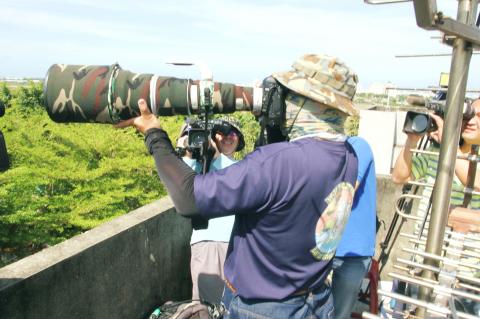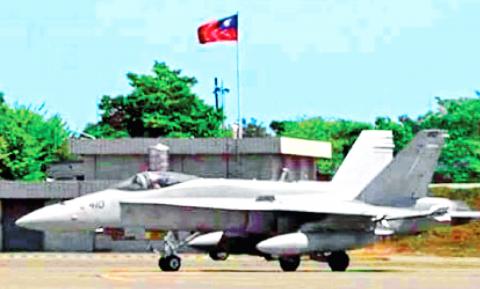A US C-130 transport plane arrived at the Tainan Air Force Base from a US Marine Corps base in Japan yesterday evening, carrying service crew to repair one of the two US F/A-18 jets that made an emergency landing in Tainan on Wednesday.
The repair crew arrived just hours after Chinese Ministry of Foreign Affairs spokeswoman Hua Chunying (華春瑩) told a regular news briefing in Beijing that China had made solemn representations to the US about the US jets landing in Taiwan.
“We demand that the US strictly abide by the one China policy and the three joint communiques between China and the US and to deal with the relevant issue prudently,” she said.

Photo: CNA
Earlier in the day, the two F/A-18s had been moved into hangars belonging to Air Asia Co (亞洲航空), which provides aircraft maintenance, repair and overhaul services at the Tainan Airport.
Meanwhile, US Department of Defense officials confirmed the two F/A-18 Hornets were from US Marine Fighter Attack Squadron 323 (VMFA-323), currently based at Marine Corp Air Station Iwakuni in Yamaguchi Prefecture, Japan.
They said the planes landed in Tainan as a precaution and there had been no injuries to the crew or damage to the aircraft.

Screen grab from the Internet
A statement by the US Marine Corps’ press office late on Wednesday said: “A persistent engine oil pressure warning light precipitated the precautionary emergency landing.”
It also said that the Tainan Airport is an US-approved divert airfield and that the jets had been en route to Singapore to participate in the “Commando Sling” exercise with the city-state’s air force.
However, according to a source in Washington, the F/A-18s were providing escort and protection for a reconnaissance mission by an EA-6B Prowler, a tactical jamming aircraft used by the US Navy and Marine Corps.
An EA-6B Prowler can carry out armed reconnaissance, electronic jamming operations and aerial surveillance tasks, and provides defense against anti-ship missiles.
The Washington source said that due to the sensitivity of its mission, the EA-6B did not land in Tainan with its escort jets, but returned to its base in Japan.
The source said the escort mission took the F/A-18s and the EA-6B on a route along the air defense identification zone over the waters off the east coast of Taiwan and it was headed to either Singapore or the Philippines.
American Institute in Taiwan (AIT) spokesman Mark Zimmer said the US C-130 transport plane, carrying US maintenance personnel and aircraft parts, landed at 8:34pm.
The maintenance crew then headed straight to the hangars to begin repair work.
An AIT team has been sent to Tainan to provide assistance, Zimmer said.
It was not immediately clear how long it would take to repair the aircraft.
A Republic of China Air Force official said the US maintenance crew was expected to stay overnight to carry out the repairs.
The F/A-18s will depart Taiwan as soon as the repairs are completed and the aircraft pass safety tests, the official added.
Air Asia is now owned by Aerospace Corp (台翔航太), but during the Cold War it was an aircraft service unit for Air America, which was created by the CIA for covert operations in East Asia and Southeast Asia.
The company is certified for maintenance and servicing of various aircraft and has links with the US aviation industry, and its location renders the Tainan Airport a US-approved divert air field.
Additional reporting by CNA

The CIA has a message for Chinese government officials worried about their place in Chinese President Xi Jinping’s (習近平) government: Come work with us. The agency released two Mandarin-language videos on social media on Thursday inviting disgruntled officials to contact the CIA. The recruitment videos posted on YouTube and X racked up more than 5 million views combined in their first day. The outreach comes as CIA Director John Ratcliffe has vowed to boost the agency’s use of intelligence from human sources and its focus on China, which has recently targeted US officials with its own espionage operations. The videos are “aimed at

STEADFAST FRIEND: The bills encourage increased Taiwan-US engagement and address China’s distortion of UN Resolution 2758 to isolate Taiwan internationally The Presidential Office yesterday thanked the US House of Representatives for unanimously passing two Taiwan-related bills highlighting its solid support for Taiwan’s democracy and global participation, and for deepening bilateral relations. One of the bills, the Taiwan Assurance Implementation Act, requires the US Department of State to periodically review its guidelines for engagement with Taiwan, and report to the US Congress on the guidelines and plans to lift self-imposed limitations on US-Taiwan engagement. The other bill is the Taiwan International Solidarity Act, which clarifies that UN Resolution 2758 does not address the issue of the representation of Taiwan or its people in

US Indo-Pacific Commander Admiral Samuel Paparo on Friday expressed concern over the rate at which China is diversifying its military exercises, the Financial Times (FT) reported on Saturday. “The rates of change on the depth and breadth of their exercises is the one non-linear effect that I’ve seen in the last year that wakes me up at night or keeps me up at night,” Paparo was quoted by FT as saying while attending the annual Sedona Forum at the McCain Institute in Arizona. Paparo also expressed concern over the speed with which China was expanding its military. While the US

SHIFT: Taiwan’s better-than-expected first-quarter GDP and signs of weakness in the US have driven global capital back to emerging markets, the central bank head said The central bank yesterday blamed market speculation for the steep rise in the local currency, and urged exporters and financial institutions to stay calm and stop panic sell-offs to avoid hurting their own profitability. The nation’s top monetary policymaker said that it would step in, if necessary, to maintain order and stability in the foreign exchange market. The remarks came as the NT dollar yesterday closed up NT$0.919 to NT$30.145 against the US dollar in Taipei trading, after rising as high as NT$29.59 in intraday trading. The local currency has surged 5.85 percent against the greenback over the past two sessions, central